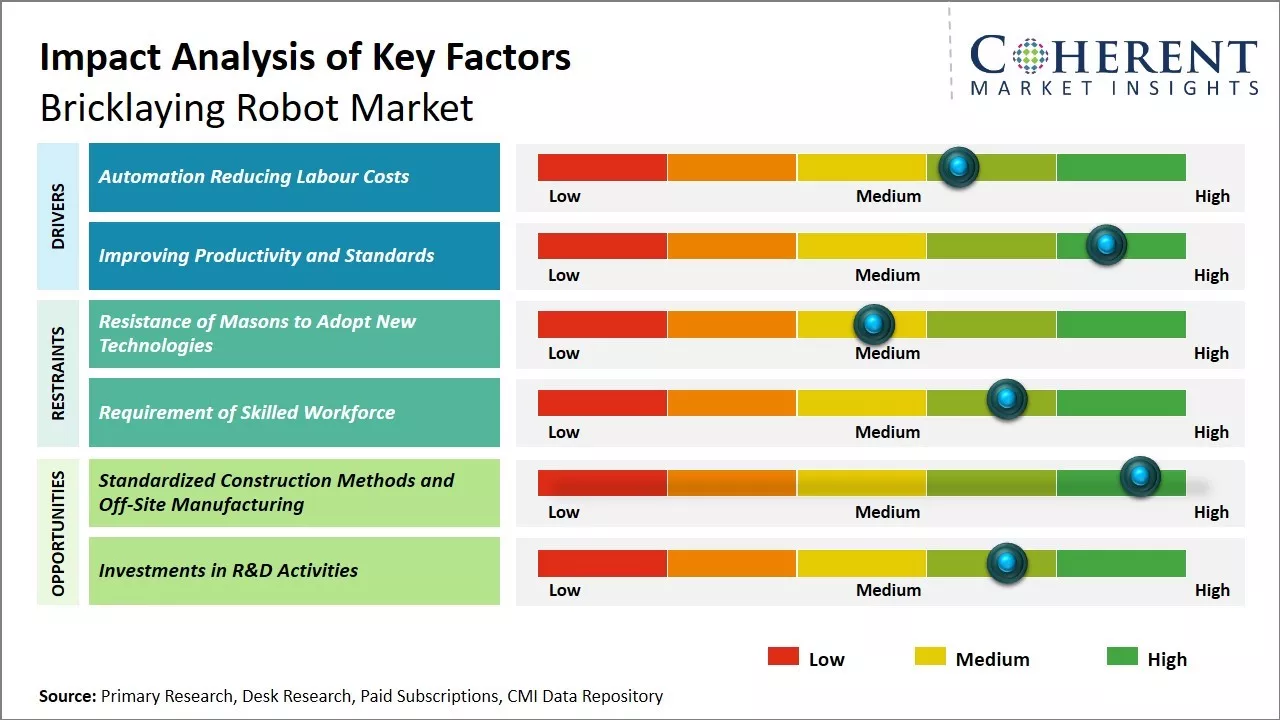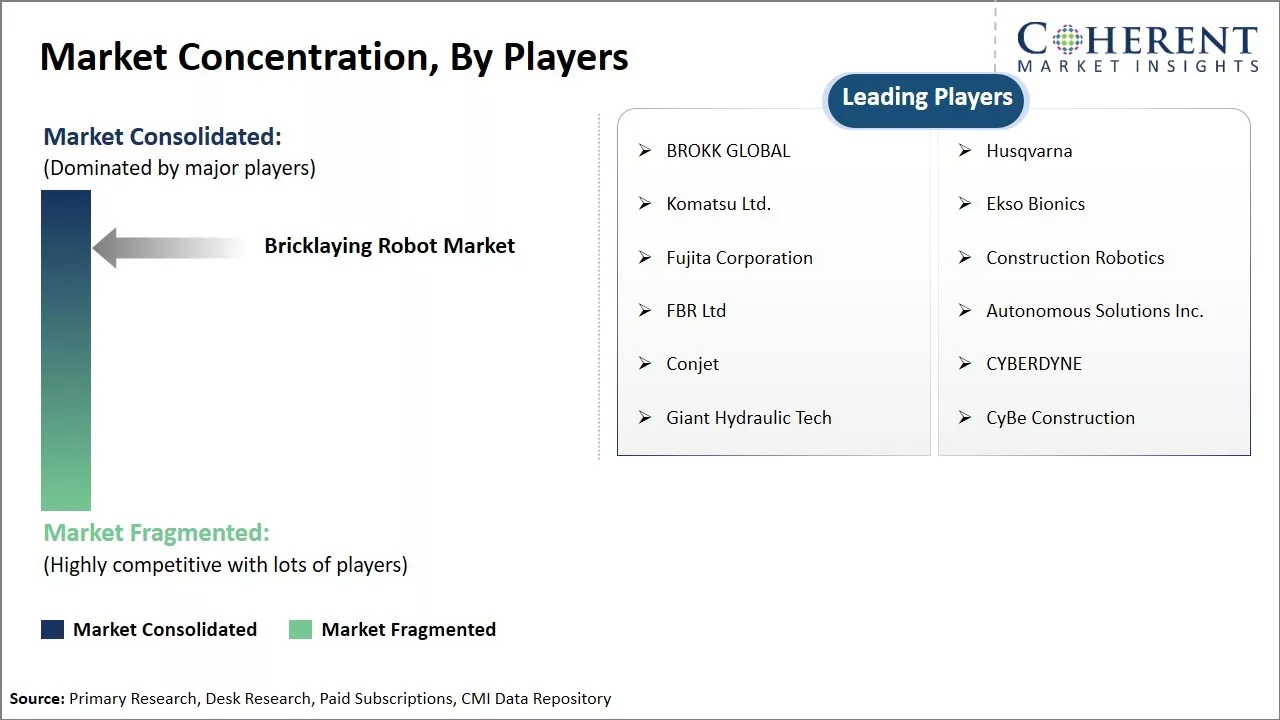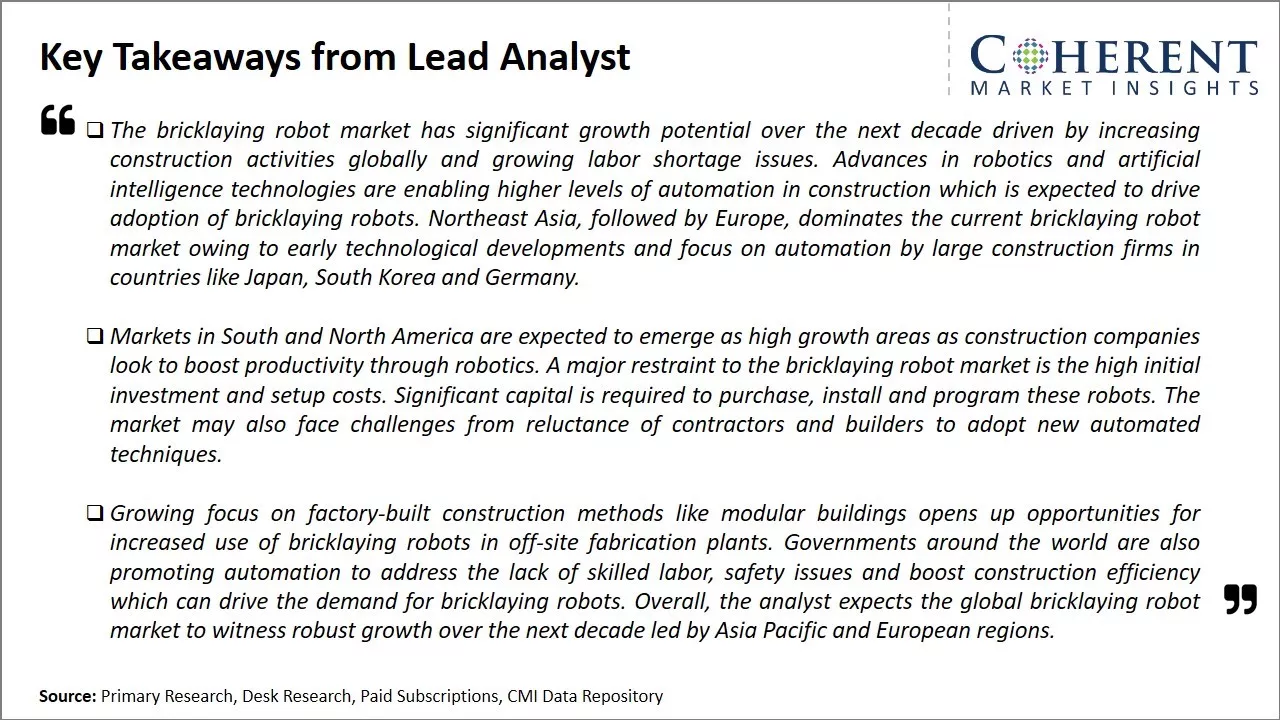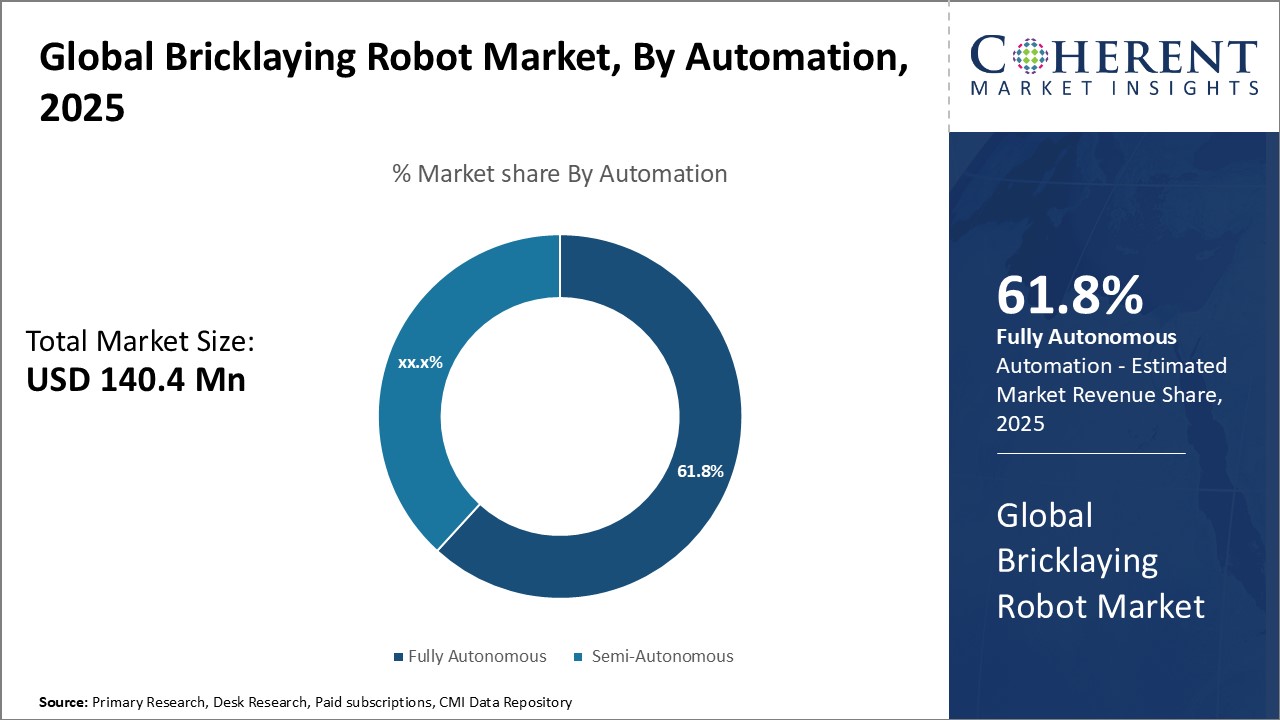Global bricklaying robot market is estimated to be valued at USD 140.4 Mn in 2025, and is expected to reach USD 360.2 Mn by 2032, growing at a compound annual growth rate (CAGR) of 14.4% from 2025 to 2032. Growing construction industry and need to improve efficiency and safety on construction sites boosts adoption of bricklaying robots. Automation can alleviate labor shortages and reduce project timelines.

Discover market dynamics shaping the industry: Request sample copy
Global bricklaying robot market is expected to witness significant growth over the forecast period. Traditional bricklaying is a labor intensive and time consuming process. Bricklaying robots address this by laying bricks much faster and with high precision as compared to manual labor. This increases productivity and allows construction of more complex designs that were not possible without automation. Various technologies like computer vision, path planning and grippers are being integrated to make bricklaying robots more intelligent and suitable for diverse construction needs.
Automation Reducing Labour Costs
The bricklaying process has traditionally relied heavily on human labour. Laying bricks is a time consuming and physically demanding task that requires skilled masons. However, with rising costs of labour across many industries, construction businesses are under increasing pressure to reduce operational expenses where possible. Automated bricklaying robots have the potential to significantly cut down on labour needs by taking over repetitive laying tasks. A single robot can work much faster than humans and lay bricks with precision and consistency. It does not require breaks or get tired like human workers. While upfront costs of robots may be high, in the long run these can replace multiple human workers and reduce wage bills. This makes robot bricklayers an attractive option for large commercial construction projects where saving on labour is a major priority. As labour shortages and costs continue their upward trend, demand is expected to grow for robotic solutions that provide a cheaper alternative to human masons.
For instance, FBR Ltd, a Perth based robotics company, has reprioritized the delivery of the Hadrian X construction robotic bricklaying solution to the U.S. due to the high demand for the technology. Following the delivery of the first of three order units, FBR’s second next-generation Hadrian X will be fitted to a U.S.-certified truck chassis and made available through a Wall as a Service (WaaS) entity in Florida.

Get actionable strategies to beat competition: Request sample copy
Improving Productivity and Standards
Another major factor driving the global bricklaying robot market is the need for higher productivity and consistency in construction operations. Building high-rise structures and large infrastructure projects within strict timelines requires maximum efficiency at every stage. Robot masons have clear advantages over human workers in this regard. These can lay bricks at a much faster rate without compromising on quality standards. Robots eliminate issues like human errors, variability between workers, and delays caused by breaks or absenteeism. These guarantee uniformity in size, positioning and alignment of each brick automatically. This helps improve overall productivity, meet tight deadlines, and avoid costly mistakes or reworks during construction. Robotic technology also allows for more complex masonry patterns that may be difficult for humans to replicate precisely. Their use ensures buildings and structures are erected according to the highest productivity and quality benchmarks. This is appealing to builders focusing on optimisation, standardisation and large-scale development activities.

To learn more about this report, Request sample copy
Market Challenges: Resistance of Masons to Adopt New Technologies
One of the key challenges faced by the global bricklaying robot market is the resistance of masons to adopt new technologies. With generations of experience, masons are hesitant to replace their skills with machines. The unpredictability of construction sites also poses difficulties as robots have limitations in responding to unstructured or unstable environments. Cost remains a hurdle as bricklaying robots require advanced sensors and effectors for precise tasks. These can be slower than skilled human masons, reducing their appeal to contractors focused on timelines.
Market Opportunities: Standardized Construction Methods and Off-Site Manufacturing
Standardized construction methods and off-site manufacturing are increasing the suitability of tasks for automation. Declining costs as technologies mature will make bricklaying robots economically viable.

Discover high revenue pocket segments and roadmap to it: Request sample copy
Insights, By Automation - Fully Autonomous segment contributes the highest share of the market owing to increased efficiency
Fully autonomous segment within the global bricklaying robot market is experiencing significant growth and is estimated to contribute market share of 61.8% in 2024 due to its ability to provide higher efficiency as compared to semi-autonomous robots. Fully autonomous bricklaying robots does not require any human assistance or intervention during the construction process, allowing them to work continuously without any delays. This enables them to lay bricks at a much faster rate compared to semi-autonomous robots which may experience down time when workers are unavailable to oversee or assist the robot. The time savings realized through full autonomy is a major driver for construction companies to adopt this technology as it allows them to complete projects ahead of schedule and take on additional projects. Fully autonomous robots are also more consistent in terms of quality of bricklaying since the process does not depend on human involvement. This has increased their acceptance especially for large, complex commercial construction sites where quality and speed of construction are top priorities. Advancing capabilities of AI, computer vision, sensors and other related technologies are also continuously enhancing the performance of fully autonomous robots, making them an attractive proposition for builders. Their ability to work efficiently in all weather conditions and terrain further strengthens the case for their adoption over semi-autonomous alternatives. Overall, the superior productivity and quality benefits offered by full automation is driving its high market share relative to other technology segments within the bricklaying robot industry.
Insights, By Application: residential buildings contributes the highest share of the market due to labor shortage
Residential buildings segment is estimated to contribute market share of 41.6% in 2025 of the global market. One of the key drivers for robot adoption in residential construction is the growing shortage of human labor. Many developed markets around the world face an aging workforce as well as declining interest of younger populations in pursuing careers in construction. This is creating a severe shortage of bricklayers for residential projects where demand for housing continues to be strong. Bricklaying robots help address this problem by augmenting the limited workforce available. These provide a way for builders to cope with rising residential construction deadlines without being dependent on availability of human masons. In the current tight labor market conditions, robots present an attractive solution to ensure timely completion of residential projects. Their deployment also improves predictability of construction schedules for home builders. Overall, robots are enabling the residential construction industry to overcome the human resource challenge, which is a major factor driving the largest share of this segment in the bricklaying robot market.

Need a Different Region or Segment? Customize now
North America has established itself as the dominant region in the bricklaying robot market. The region is estimated to account for 35.7% in 2025 of the global market, led by high demand from the U.S. Factors such as advanced construction technology adoption, presence of major robotics companies and skilled workforce have aided North America's leadership position. Several U.S based construction firms have integrated robotic solutions as part of their construction methodology to enhance productivity and meet large project deadlines. Cost savings achieved through robotic bricklaying has increased its popularity among commercial and housing contractors. North American robotics manufacturers have also increased investments in developing technologically advanced bricklaying robots specific to regional construction practices. With the U.S expected to undertake major infrastructure projects, demand for bricklaying robots is projected to rise further strengthening North America's stronghold.
The Asia Pacific region has emerged as the fastest growing market for bricklaying robots globally. China dominates the regional as well as global bricklaying robot installations due to sustained high investments in public infrastructure and housing sectors over the past decade. Robotic technologies are increasingly adopted by Chinese constructors to address acute labour shortage issues. Countries like India and Japan are also witnessing increased utilization of bricklaying robots supported by government initiatives for smart urban development. Southeast Asian countries with rapid urbanisation present untapped opportunities for bricklaying robot suppliers. The availability of low cost labour initially restricted robotic adoption, however growing wages and shortage of skilled workforce are compelling factors for considering robotics. Local bricklaying robot manufacturers have benefitted from rising regional demand and continue expanding product offerings tailored to Asia Pacific construction demands.
Global Bricklaying Robot Market Report Coverage
| Report Coverage | Details | ||
|---|---|---|---|
| Base Year: | 2024 | Market Size in 2025: | USD 140.4 Mn |
| Historical Data for: | 2020 To 2024 | Forecast Period: | 2025 To 2032 |
| Forecast Period 2025 to 2032 CAGR: | 14.4% | 2032 Value Projection: | USD 360.2 Mn |
| Geographies covered: |
|
||
| Segments covered: |
|
||
| Companies covered: |
BROKK GLOBAL, Husqvarna, Komatsu Ltd., Ekso Bionics, Fujita Corporation, Construction Robotics, FBR Ltd, Autonomous Solutions Inc., Conjet, CYBERDYNE, Giant Hydraulic Tech, CyBe Construction |
||
| Growth Drivers: |
|
||
| Restraints & Challenges: |
|
||
Uncover macros and micros vetted on 75+ parameters: Get instant access to report
*Definition: The bricklaying robot market consists of robotic machines that can lay bricks automatically with precise positioning and uniform spacing and jointing. These robots use computer vision systems and advanced sensors to detect the location of bricks and mortar. These have multi-axis arms and end-effectors that can pick up bricks from a tray or conveyor belt and place them exactly where required on the foundation. Bricklaying robots can significantly increase construction productivity and help overcome labor shortages in the brick masonry industry.
Share
Share
About Author
As an accomplished Senior Consultant with 7+ years of experience, Pooja Tayade has a proven track record in devising and implementing data and strategy consulting across various industries. She specializes in market research, competitive analysis, primary insights, and market estimation. She excels in strategic advisory, delivering data-driven insights to help clients navigate market complexities, optimize entry strategies, and achieve sustainable growth.
Missing comfort of reading report in your local language? Find your preferred language :
Transform your Strategy with Exclusive Trending Reports :
Frequently Asked Questions
Joining thousands of companies around the world committed to making the Excellent Business Solutions.
View All Our Clients
US Reciprocal Tax Impact Analysis On Global Bricklaying Robot Market
Stay updated on tariff changes with expert insights and timely information